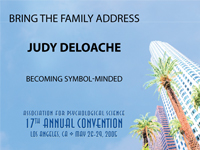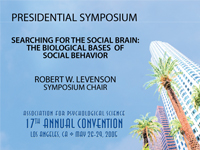Animated Expressions

Pete Docter of Pixar demonstrates how he and other animators constructed the animated expressions for Mike and the other characters of Monsters, Inc., regardless oh how many eyes they have.
One of the buzz-generating highlights of the APS Annual Convention in Los Angeles was an “animated” roundtable discussion between Pete Docter of Pixar Animation Studios and two giants (you might even call them Incredibles) of emotion research, Paul Ekman, University of California, San Francisco and Dacher Keltner, University of California, Berkeley, on the subject of animation and emotion.
For nearly two decades, Pixar, the studio that produced hit animated films including Toy Story and last year’s The Incredibles, has been at the forefront of using digital animation to create highly expressive screen characters. Docter, who worked on both Toy Story and Toy Story II and directed the 2001 hit Monsters, Inc., brought a number of video clips showcasing the ability of animators, puppeteers, and other filmmakers to simulate a wide range of human (and quasihuman) emotion on-screen.
According to Docter, “Everything at Pixar is very steered toward gaining new knowledge and information.” Early on, he said, their team of digital artists drew heavily on the work of Ekman and other psychologists in thinking about the expression of emotion, for instance using the Facial Action Coding System that Ekman and a colleague devised in the 1970s for the classifying and analyzing of facial muscle movements. Later, Docter said, Pixar animators’ approach became more intuitive, based on their own observations of people.
The work of Pixar’s artists passes muster, Ekman said; he remarked, for example, on the accuracy of the facial expressions in Geri’s Game, a 1997 Pixar short about an old man who plays a very heated game of chess … against himself. The only error Ekman found after several viewings of the film was a slight mistake in the wrinkling of the codger Geri’s forehead.
Ekman, who visited Pixar’s facility earlier this year, noted that “They look in as fine detail as we do in our research. … Pixar animators are looking and creating at an extraordinarily fine-grained level.”
But while realistic in their approximation of human facial muscle movements, the emotional reactions displayed by Pixar characters are often highly exaggerated. Keltner noted that, while the emotional expressions of the characters are perfect, “you cut out all the ambiguous things that humans do with the face.” Docter explained that animators use heightened contrasts — highlighting the extreme emotional reactions, getting rid of the smaller, more ambiguous muscle movements and expressions that real people would display — in order to heighten the drama in the story and to more clearly reveal the characters’ personalities. Keltner observed that such a principle of exaggeration and contrasts “may be true of human personality as well … It’s our extremes that tell us who we are.”
Emotion is not only about the face and facial muscles. Ekman pointed out that the expression of emotion, first studied scientifically by Charles Darwin, is a “multiple signal system” in which the rest of the body comes into play. Keltner and Ekman noted that people with facial paralysis are still able to express emotions, even though a major channel of expression has been taken away. Underscoring this point, Docter showed a film clip of the Muppets, whose faces have only limited ability to move, demonstrating that emotions can be expressed and understood through many channels (voice and gesture, for example) and not just the movement of facial muscles.
Docter explained that, to not rely too heavily on facial expressions, Pixar animators deliberately work from the bottom up — doing as much as possible to express emotion using characters’ body movements, gestures, and simple timing of reactions — and only animate characters’ faces as a final step.
Despite the great advances in digitally simulating human body movements and facial reactions, Docter said that the success of all animation rests on the role of audiences in supplying emotional reactions that may not really be visible on screen at all. As “an example of why what we do works,” Docter opened his presentation by showing a non-animated, non-Pixar-made IKEA ad (made by the video and film director Spike Jonze) in which a replaced and discarded lamp, put out on a rainy sidewalk with the trash, generates sympathy just from the way it is filmed and the music that accompanies it.Ekman observed that simply “our propensity to animate objects” makes the lamp appear forlorn and sad — an impression comically deflated when a man appears on-screen at the end and informs the audience: “Many of you feel bad for this lamp. That is because you’re crazy. The lamp has no feelings, and the new one is much better.” This propensity to imbue objects with human emotions is, Docter said, “just hardwired — which is great for us, because we don’t have to work as hard!”
Animation and puppetry (as in the Muppets example) engage audiences, Docter said, because “The audience is invited and required to put their own reading into what they are seeing on the screen. They’re not given everything, they’re not spoon-fed everything. And it involves you more … because you are intentionally leaving some detail out.”
Although Pixar is known for pushing the envelope in creating highly detailed digital worlds and characters, it is the details that are left out that help create memorable stories and generate involvement — what Ekman called “capture.” “That’s why you go to animated films, I think,” Docter noted. “It’s life distilled to its essence, like a great reduction sauce.”




APS regularly opens certain online articles for discussion on our website. Effective February 2021, you must be a logged-in APS member to post comments. By posting a comment, you agree to our Community Guidelines and the display of your profile information, including your name and affiliation. Any opinions, findings, conclusions, or recommendations present in article comments are those of the writers and do not necessarily reflect the views of APS or the article’s author. For more information, please see our Community Guidelines.
Please login with your APS account to comment.